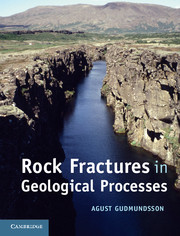Book contents
- Frontmatter
- Contents
- Preface
- Acknowledgements
- 1 Introduction
- 2 Stress
- 3 Displacement and strain
- 4 Relation between stress and strain
- 5 Loading of brittle rocks to failure
- 6 Stress concentration
- 7 Theories of brittle failure of rocks
- 8 Extension fractures and shear fractures
- 9 Displacements and driving stresses of fractures
- 10 Toughness and fracture mechanics
- 11 Field analysis of extension fractures
- 12 Field analysis of faults
- 13 Evolution of extension fractures
- 14 Evolution of faults
- 15 Fluid transport in rocks – the basics
- 16 Fluid transport in faults
- 17 Fluid transport in hydrofractures
- Appendix A Units, dimensions, and prefixes
- Appendix B The Greek alphabet
- Appendix C Some mathematical and physical constants
- Appendix D Elastic constants
- Appendix E Properties of some crustal materials
- Index
- References
3 - Displacement and strain
Published online by Cambridge University Press: 05 June 2012
- Frontmatter
- Contents
- Preface
- Acknowledgements
- 1 Introduction
- 2 Stress
- 3 Displacement and strain
- 4 Relation between stress and strain
- 5 Loading of brittle rocks to failure
- 6 Stress concentration
- 7 Theories of brittle failure of rocks
- 8 Extension fractures and shear fractures
- 9 Displacements and driving stresses of fractures
- 10 Toughness and fracture mechanics
- 11 Field analysis of extension fractures
- 12 Field analysis of faults
- 13 Evolution of extension fractures
- 14 Evolution of faults
- 15 Fluid transport in rocks – the basics
- 16 Fluid transport in faults
- 17 Fluid transport in hydrofractures
- Appendix A Units, dimensions, and prefixes
- Appendix B The Greek alphabet
- Appendix C Some mathematical and physical constants
- Appendix D Elastic constants
- Appendix E Properties of some crustal materials
- Index
- References
Summary
Aims
This chapter gives an overview of the concepts of displacement and strain. In textbooks on structural geology, strain is normally treated in great detail. The reason is that strain, particularly finite strain, is of fundamental importance for understanding the kinematics of ductile deformation, such as occurs during folding. Here, however, the focus is on those aspects of strain that are useful when analysing stress-strain relations for brittle rocks, which to a first approximation behave as linearly elastic and are subject to small (usually less than 1%) strain. The main aims of this chapter are to:
Explain the difference between displacement and strain.
Provide examples of the use of each concept in geology.
Explain the difference between deformation and strain.
Discuss general aspects of infinitesimal strain.
Provide some basic formulas for measuring strain.
Discuss strain rates and how they are measured.
Basic definitions
Displacement refers to the change in position of a particle. When the displacement is very small, it is referred to as infinitesimal; when large, it is referred to as finite. Strain is also related to the displacement of particles from their original position to a new position. Strain and displacement are thus closely related. There is, however, a significant difference. Strain always involves changes in the internal configuration of the body. During strain, the distances between the particles that constitute the strained body change.
- Type
- Chapter
- Information
- Rock Fractures in Geological Processes , pp. 63 - 88Publisher: Cambridge University PressPrint publication year: 2011



